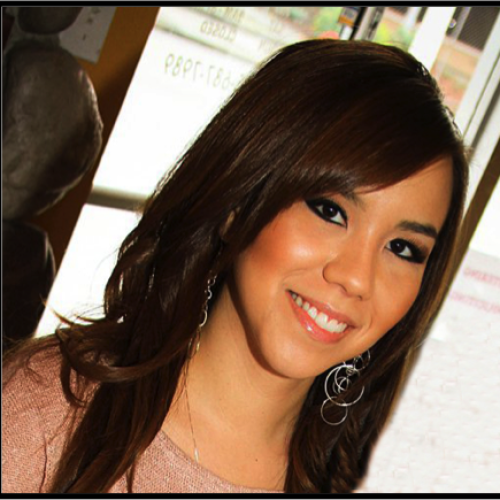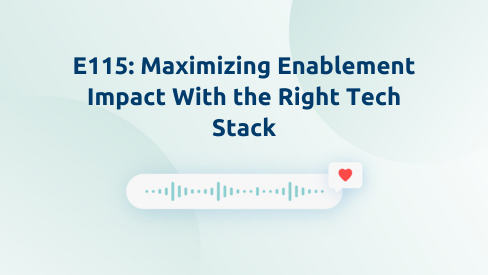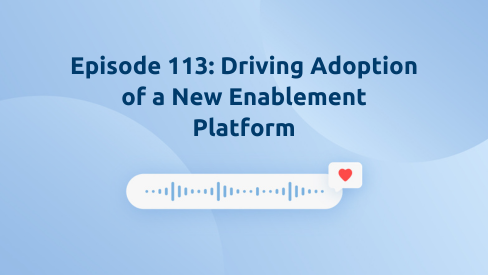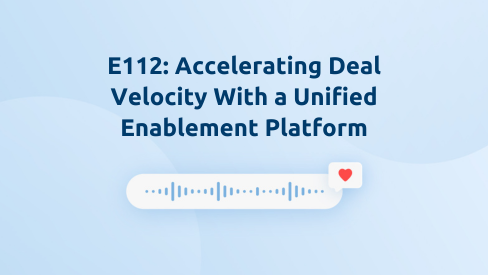Research from Sales Enablement PRO’s State of Sales Enablement Report found that organizations that understand what content engages buyers are 38% less likely to struggle with sales velocity. So, how can you optimize the customer experience to improve buyer engagement through enablement?
Shawnna Sumaoang: Hi and welcome to the Win Win Podcast. I’m your host, Shawnna Sumaoang. Join us as we dive into changing trends in the workplace and how to navigate them successfully. Here to discuss this topic is Denise Romero, director of learning and development at Hunter Douglas. Thanks for joining, Denise! I’d love for you to tell us about yourself, your background, and your role.
Denise Romero: Thank you for having me. Like you said, my name is Denise Romero. I’m with Hunter Douglas. I’m the director of our learning and development department here. A little bit about myself, I have a degree in organizational development, so I kind of feel like I’m in the right space, which is rare for a lot of folks.
How I got my start and my passion truly for what I do goes back in time. I originally set out to be a teacher actually, and I realized at some point that kids were not my cup of tea. I pivoted and I had really good role models. It always intrigued me how they were able to dumb down things and really make it simple for new hires and employees to come in and learn the role.
As I progressed and became a leader in the organization, I really gravitated towards that space and how I can look at content, and how I can create an experience for employees. It’s not intimidating. I think we lose sight of that sometimes, especially when we’ve been in an organization for a long time. It’s really driven a lot of my passion through the years is trying to solve content and training and that knowledge and how you have that knowledge transfer. It fascinates me.
That’s a little bit about my background here at Hunter Douglas. I’m responsible for a variety of different things, quite honestly, in North America. Internally, we talk about our internal sales team and our customer support team and L&D is responsible for integrating these folks into the business. I like to say that human resources onboards and it’s L&D’s job to integrate them, teach them how to swim, teach them how their role provides value to the greater organization, and then really set them up for success with a solid foundation and give them an opportunity to progress.
As they’re an employee here, externally facing, we have an interesting model. We’re a B2B2C. We focus primarily on our dealers who are selling our product. When you think about that the challenge that we’ll probably dig into at some point is that they don’t have to take training for us. They don’t have to really do anything that we’re putting out into the world. We have to be really creative. That starts with our partnership with our sales team because they’re truly guiding our dealers to help them have a successful business and to really market and sell Hunter Douglas products.
SS: I love that. I definitely want to dig in. I’d love to start at the beginning before implementing Highspot. What were some of the challenges facing your team that caused you to consider investing in an enablement platform?
DR: That’s a great question. Our biggest challenge was the fact that we didn’t have anything. There was no Northstar, there was no true guidance. From my perspective, you had regions throughout North America doing things very differently. It’s almost as if they were operating as their own business unit and their own business. You wouldn’t see consistencies on how products were being talked about, and how content and resources were being shared. A lot of it was being homegrown and there was a lack of governance.
What we were looking to solve was how we create a consistent repeatable process. It was really prescriptive. How can our sales team not have to be inefficient and think about all of these things that they would need to build? How can we build it for them and really develop a one-stop shop where they know they can go get this information and we start to cascade that across the entire region through North America?
SS: I love that. Since implementation, how have you been able to solve some of the challenges that your team is facing?
DR: We really looked at this with a big lens. We started to think about what’s most important to us. How do you create that foundation? That foundation really is our product. We wanted to ensure first and foremost that we had a very prescriptive play and pitches to ensure that there wasn’t confusion. We want our consumers to know that when they’re talking to a dealer they’re being given accurate information and it’s being given with confidence. That’s where we really started from there.
We started to tackle, what are some of the initiatives. What are some of the pain points? We built that template out? We also really looked at the user experience within Highspot to ensure that it wasn’t complicated. How can we break the content down into categories that the salesperson can easily look at at a glance and see what they need? What do they need to say? What do they need to do? We then showed those simple things that will help them be successful when they’re talking to their dealer.
SS: At the onset, you had mentioned Hunter Douglas has a unique sales cycle, which means that you also have unique ways of leveraging Highspot. Tell us more about this. How do you leverage Highspot to educate your external dealers to effectively sell your products?
DR: It’s a unique relationship. As I said, we’re a B2B2C, so our sales team has to think about that from the lens of how they manage an account. How do they educate? How do they inform? How does that information get passed on to our dealers? In our instance, our sales team will take any content that we have developed and built within Highspot, and as I said, we’ve really created consistent templates, no matter what the content is.
Whether it’s a pain point, whether it’s a company initiative, whether it’s product information, and we don’t stray from that. That really helps them absorb the information. First and foremost, we teach our district sales managers, DSMs, what they need to know about this thing. It’s really their self-guided learning, and then we start to layer onto that or what we would say, scaffolding. We want them to know, how you talk about this now with your dealer, and what you show them. What do you want them to do? What’s that action that you want them to take? Then they can basically think about it as performance management.
Their job is to really identify for the dealer, where are the obstacles, or what the things that you need to do in order for your business to be successful. That gets transferred and cascaded, and there’s not a consistent recipe. I would say in that little bucket, because each dealer is different, and in our world, you can have a dealer that sells all window coverings, or you can have a dealer that sells window covering, paint, and other topics that are home furnishing goods. We really have to be creative in how that information gets cascaded to our dealer for success.
SS: For our audience, what role do district sales managers play in enabling dealers through Highspot? And how do you tailor enablement programs to support your district sales managers?
DR: That’s also a great question. I’ll go back to what I was saying, but think of it as a recipe. This is what we do when any cook is building or making a dish. There’s a foundation. You have your ingredients, you have your quantity of ingredients, and you have your instructions on how to put that all together. That’s what we’re providing.
Where I think the nuance for us is that every dealer is different. We have to tailor some of that content based on their preferences. First and foremost, we do that, but another key element that we do, and we do this yearly, is we think about goal setting for our dealers. We really look at the uniqueness of the business. We create goals in a scorecard. We bring that into Highspot so they understand how to represent themselves to provide that coaching and guidance, and truly being a consultant to our dealer’s business. That’s how we’re using Highspot in a different way, compared to more B2C versus the B2B channel that we sit in.
SS: For our audience, how is enabling internal sales teams different from enabling external dealers?
DR: I think for us, where we found success, we started small. We started with our products, which most people internally know, and that led to success for us because the sales team had trust in the platform from there, we really built off of that. Again, it’s that mindfulness. For us and that adoption success internally, it was about explaining to the sales team that we’ve now made their roles more efficient for them. You don’t have to start from scratch. We’ve taken the thinking out of it for you. You have all of this in one place, which is inclusive of resources, inclusive of guiding, and coaching.
We’ve added video recordings so they can do role-playing or watch role-playing. We’ve added audio. They literally have examples. There are so many resources that we’ve been able to really wrap our arms around and put within Highspot the successes that we built the confidence and the trust in the tool. That’s why we continue to have the adoption that we see.
SS: Now, across all of the teams that you support through enablement, one of your areas of passion is curating an excellent customer experience, which I can deeply relate to. How do you leverage Highspot to improve the customer experience?
DR: Customer experience is important to me. Not only do I sit under the customer experience umbrella, I think just as a consumer, especially in this day and age, we can’t lose sight of how that experience can impact a business and what it really means to not only the end consumer but the business itself. We are very picky in the people we allow to play within Highspot in regards to content design and development.
We don’t let more than three people in the tool itself. When we think about a project, we think about an initiative, there’s a sales training manager who takes control of basically herding the cats. Where we build a project plan, we build intent and a charter. I have a content leader who sits within this project plan and thinks about the content and all the necessary tools that need to go into Highspot and then I have a developer and that’s it. We don’t let a lot of people into this and it really creates a consistent experience internally, which is also super important for us externally.
How it translates to our dealer and then ultimately the consumer, represents who we are as a brand. We are not skipping a beat in regard to our brand. We start internally and that obviously shows up on the end side of the consumer. We also have tight governance around it. We’re really looking at everything that’s getting put into there. That’s not only from the development standpoint, but it’s through auditing and maintaining. We have made Highspot part of our day-to-day world here. That’s really the secret that I think that we found for us to be successful.
SS: I love that. You have seen a lot of success and have engaged customers through Highspot. You have an incredible 95% adoption of pitch capabilities. What are your best practices for leveraging pitching in Highspot to improve buyer engagement?
DR: I would say the one word to define that is partnership. We don’t operate on an Island. As soon as there’s new information being added to the sales team, whether it’s from learning and development, or it’s an ask for us to support them, we build everything out and we sit down with the entire sales team and an all-hands on call. We’re meeting them where they are. There’s not a surprise. They understand why we’re doing it, what they need to do with it, and the action they need to take from it. That’s really helped us see our adoption rate skyrocket and ultimately our engagement externally.
SS: Fantastic. In terms of metrics, what are you tracking to see the overall impact you’re having on the business through your enablement efforts?
DR: We’re really looking at our engagement and our adoption. We look at time spent and we’re also, in the latter part of this year, tracking our region scorecards. Not only at the regional level but at the individuals within those regions. Primarily there, we’re looking at similarities and differences. Do we see consistency regarding key initiatives and time being spent internally to understand what the pitches and plays are and how is that being pushed externally? If there’s a difference, we can socialize that again through our all-hands meeting. We call attention to it.
That has been interesting for us to watch because, at the beginning, our adoption rate was key. That was our KPI. We really wanted to build this and watch the adoption. We got there fairly easily. Now it’s trying to figure out what the markers are, and what’s really driving people to gravitate towards one thing or another.
Lastly, while we’re not there yet, we really want to start to figure out the impact of sales, whether that’s dollars or units. The reason we haven’t gotten there yet is because of our own internal challenges with Salesforce integration. We believe in 2024 when we turn that on, we are going to have success where we can truly tie back the return on investment to some of these key initiatives from the company. Then, also, pain points that are identified that we can throw our efforts towards to help the sales team be more successful when they’re out speaking with our dealers.
SS: I love that and you guys are definitely making your way up the maturity curve very quickly I have to say, so it’s impressive. Last question for you, Denise. What are some of the business results that you’ve seen so far with Highspot and do you have any wins you’d like to share with our audience?
DR: We had a great win at the beginning of the year. We rolled out a project called the Federal Tax Credit. What this is, it gives our consumers an opportunity to get a rebate on certain qualifying products. We spent a lot of time not only internally within L&D thinking about the template and thinking about how our DSMs need to educate our dealers, but a partnership was also formed with our product management team.
This is the ideal model, in our opinion, where we are the developers and the designers of the content hearing from a company initiative and then partnering in this instance with product management. Ideally, we want to duplicate that across the organization, but these three core functions came together, understood how a DSM has to talk to a dealer that would ultimately impact our consumers.
If you think back to our original question, I have no responsibility to our consumers. I’m really only responsible for our dealers and we have seen a huge success. It’s our number one piece of content that is consumed to this day on a regular basis. We’re maintaining it and we’re ensuring that if we see a gap anywhere across the functions that I just identified, we reiterate, we guide, and we tweak the success on the other side for our consumers. We consider it a success. We also consider it the template that we need to keep using as we develop and continue to expand and grow within ourselves as we work on this particular type of enablement. Truly Highspot is the bow that’s helping us create that success.
SS: I love hearing that, Denise. Thank you so much for joining us today and sharing with us the unique ways you’re leveraging Highspot at Hunter Douglas. I really appreciate the time.
DR: Yeah, of course. Thank you for having me.
SS: To our audience, thank you for listening to this episode of the Win Win Podcast. Be sure to tune in next time for more insights on how you can maximize enablement success with Highspot.




